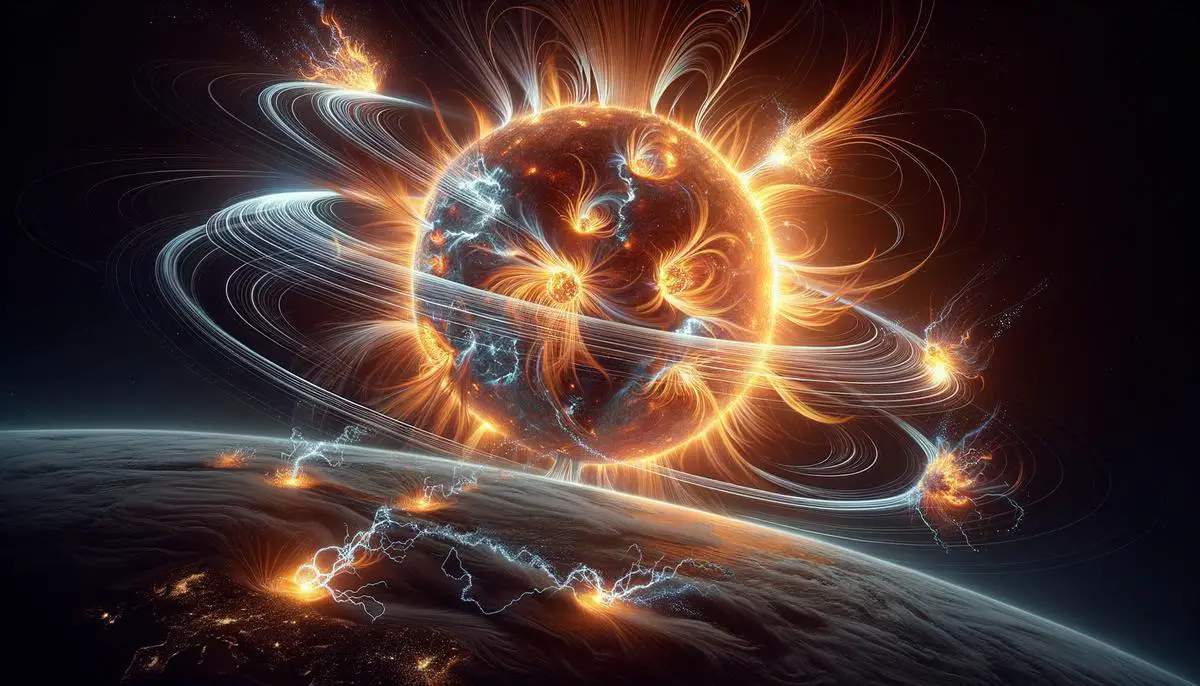Imagine standing on the brink of a cosmic event, where the sun's fiery temper flares into a spectacle that reaches across the vastness of space to touch our lives here on Earth. This is the stage where solar flares and geomagnetic storms play out their dramatic roles, casting a light on the intricate dance between our planet and its star. As we peel back the layers of these solar phenomena, we uncover their impact on technology, natural wonders, and even the rhythm of our daily lives.
Understanding Solar Flares
Imagine the Sun, a giant magnetic ball of gas, suddenly snapping. This snap isn't small but a gigantic burst of energy sending waves of high-energy particles across the solar system. This event is what scientists call a solar flare. It's like the Sun throwing a tantrum, and when it does, it doesn't hold back.
Solar flares kickstart with a powerful release of magnetic energy caused by crossed magnetic field lines on the sun's surface. Think of it as if the Sun had too many wires crossed and decided, "It's time to reset!" Except, its reset button sends out a robust burst of radiation, including X-rays and ultraviolet light that zips across space at incredible speeds.
Solar flares classify into A, B, C, M, or X categories, with A being the least intense and X the most explosive. Each class multiplies by 10 in power, so when we hear about an X-class flare, it's time to sit up and take notice. These are the big ones, capable of causing quite a stir in the Earth's magnetic field.
When these energy waves hit Earth, they create beautiful auroras, those stunning light shows near the poles. However, it's not all pretty lights; intense solar flares can disrupt power grids and satellites, influencing everything from our cell phones to navigation systems.
The process starts quietly, beneath the visible surface of the Sun, in regions spotted with sunspots. These spots are cooler areas fraught with intense magnetic fields. When these fields get too tangled, they snap and release solar flares. You can think of sunspots as moody patches that, when they get too stressed out, lash out in spectacular, space-altering fits.
At times, solar flares accompany coronal mass ejections (CMEs), massive bubbles of gas and magnetic field ejected into space. While solar flares speed to the Earth at the speed of light, CMEs take their time, traveling slower but possibly bringing more disruptive energy to our magnetosphere.
Solar flares are the Sun's way of readjusting its magnetic field's balance but in a dramatic explosion of energy that sprints across space. Their occurrence reminds us of the dynamic nature of our closest star and its unforeseeable impact on the technology and natural phenomena we often take for granted on Earth.

The Phenomenon of Geomagnetic Storms
When solar winds and coronal mass ejections, large expulsions of plasma and magnetic field from the Sun's corona, reach our planet, they can cause what are known as geomagnetic storms. These interactions with Earth's magnetosphere, an invisible shield that protects us from solar and cosmic radiation, can lead to significant ramifications both in the atmosphere above and on the ground below.
As these electrically charged particles from the Sun collide with Earth's magnetosphere, they can travel down the magnetic field lines toward the poles. Here, they add energy to the oxygen and nitrogen atoms in the upper atmosphere, leading to the creation of an awe-inspiring light show called the aurora borealis or northern lights in the north, and aurora australis, or southern lights in the south. Not just a treat for the eyes, these displays are poetic reminders of our star's power.
Beyond the beauty, these magnetic squalls exert strain on our magnetic field through a process called geomagnetic induction. This can generate electrical fields in the Earth's surface, playing havoc with our engineered systems. Power grids can face significant challenges during these times. Extended geomagnetic storms have been known to induce currents in power lines, which can overload systems and even lead to widespread blackouts.
The impact extends above the Earth too — satellites, crucial to our communication and navigation systems, can witness the storm's fury. They may be subjected to additional radiation, which can damage electronics and disrupt their operations. It's not an alien attack but rather our star reminding us of its influence on our high-tech existence.
There is ongoing research into the potential effects of geomagnetic storms on human health. While our bodies are largely shielded from the immediate impact by Earth's atmosphere and magnetic field, it is theorized that the increased radiation might affect us in less direct ways, particularly for those at high altitudes. The theory stems from concerns about increased ambient radiation levels during flights, especially over the poles, where protective magnetic shielding is weaker. While direct effects are still a matter of debate, it highlights the complex relationships between celestial events and life on Earth.
Telecommunication blackouts are another inconvenience of these geomagnetic tantrums. As the storm distorts Earth's magnetic field, it can interfere with radio waves journeying across the ionosphere, leading to frustrating disruptions in communication, from radio signals to GPS functionality. Imagine driving through an unknown city without GPS guiding your turns — it quickly reminds us of our dependency on technology finely tuned to a calm space environment.
While geomagnetic storms serve as vivid reminders of our sun's power and the beauty of nature's light shows, they also highlight our vulnerabilities. Our increasing reliance on technology intertwinned with a greater understanding of these cosmic phenomena pushes us to find ingenious ways to safeguard our systems. It's a cosmic dance of balance between embracing the marvels of the upper atmosphere and ensuring our feet remain grounded in preparedness.

Comparative Analysis of Solar Flares and Geomagnetic Storms
Solar flares originate from the sun when magnetic energy, stored in the sun's atmosphere, is suddenly released. This magnetic upheaval triggers bright, intense outbursts, often near sunspots areas where magnetic fields are at their most intense. In contrast, geomagnetic storms begin when solar wind, a continuous flow of charged particles from the sun, and material from coronal mass ejections (CMEs) disturb the Earth's magnetosphere, the protective magnetic bubble that surrounds our planet.
Solar flares primarily affect Earth's upper atmosphere causing ionization that can disrupt satellite signals and radio communications.1 On a brighter note, they contribute to the mesmerizing glow of auroras near polar regions. In comparison, geomagnetic storms, born from interactions with the Earth's magnetosphere, can significantly distort Earth's magnetic field lines, amplifying the effects on technological systems. This distortion impacts not just satellite operations but can induce currents strong enough to overwhelm power grids and disrupt compass directions.
Technologically, while solar flares might lead to temporary disruptions in communication systems, geomagnetic storms wield the power to induce currents that can fry electrical transformers and cause prolonged blackouts.2 This disparity points to the fact that geomagnetic storms pose a more severe threat to Earth's infrastructural stability.
Biologically, while the immediate health impacts from both solar flares and geomagnetic storms on humans are minimal due to Earth's atmosphere offering protection against solar radiation, shifts in geomagnetic fields have been speculated to impact animal navigation, particularly in species sensitive to magnetic cues.3 Similarly, astronauts in space or at the International Space Station experience increased exposure to radiation from these solar events, requiring protective measures.
While solar flares dazzle with bursts of electromagnetic energy high above Earth, geomagnetic storms orchestrate a more tangible, sometimes disruptive dance with Earth's magnetic fields and technology. Both phenomena underscore our planet's complex relationship with our nearest star, highlighting not just the wonders of the universe but the need for continued vigilance and understanding of space weather's potential impacts on our terrestrial home.

Technological Vulnerabilities and Protective Measures

Historical Events and Future Predictions
In 1859, Richard Carrington observed a flare that sparked telegraph fires and allowed auroras to be seen as far south as Cuba and the Caribbean, leaving us our first taste of the raw power that solar eruptions can unleash.4 Fast forward to March 1989, when a geomagnetic storm darkened Quebec, Canada, pushing six million people into darkness for about nine hours, disrupting electric grids and causing auroras that painted the night sky far beyond their usual northern home.
By July 2000, during the Bastille Day event, a mighty solar eruption spiked, leading to satellite malfunctions and radio blackouts. This instance ranked high on the scale of solar events, showcasing the direct consequences that such storms can wield on both technology and the Earth's magnetic field. The Halloween Storms of 2003 took this scenario to a new level, affecting aircraft navigation, satellites, and even causing the temporary failure of the Solar and Heliospheric Observatory; these storms illustrated how solar activity does not calm quickly after reaching a cycle's peak.
The furious sun unleashed again on December 5, 2006, when an X9-class flare torched communications and GPS signals for minutes, proving how delicate our technological systems remain in the face of solar temper. Fast forward to February 2022, and we witness SpaceX grappling with the ferocity of our star as up to 40 of its Starlink satellites succumb to a geomagnetic storm shortly after deployment, forecasted damages soaring beyond $50 million.5 This event underscored the financial and operational risks posed by intense solar and geomagnetic phenomena, setting back even fleeting aspirations in space exploration and exploitation.
Such past episodes give us a historical precedent, revealing tangible impacts across society and technology immersed within our sun's tempestuous nature. Looking toward the horizon, as we edge closer to the predicted solar maximum of 2025 in this 25th solar cycle, the potential looms for more frequent and amplified solar activities. Current trends point to an uptick in both solar flares and geomagnetic storms, suggesting an escalation of both awe-inspiring auroras and possible disruptions akin to those seen in historical events.
This prognosis invites an inevitable contemplation of future impacts on global infrastructure, where power grids might once again teeter on the brink, satellite communications risk compromise, and navigation systems falter. Evaluation and fortification of our technological vulnerabilities have witnessed incremental advancements since the vulnerable days of March 1989 or the telegraph tribulations following the Carrington Event. However, the dance with cosmic forces far outstrips these measures, firmly asserting the unpredictability and might of solar temper tantrums.
Future scenarios animate the compelling need for adaptable infrastructures capable of withstanding solar invectives while emphasizing intensified global cooperation in forecasting, monitoring, and responding to these celestial challenges. As humankind scales newer technological heights—from interconnected global networks to deep space expeditions—the elemental fury of our star reminds us of our terrestrial tethers. Preparing for future outbursts thus morphs into a crucial storyline in the broader narrative of human progress and survival amidst the whims of cosmic weather.

In wrapping up our journey through the dynamic interplay between solar flares, geomagnetic storms, and their terrestrial impacts, it’s clear that these celestial events are more than just spectacular shows in the sky. They are vivid reminders of our sun’s power and its direct influence on Earth’s technological fabric and natural beauty. As we look toward the future, understanding and preparing for these solar outbursts becomes not just an academic pursuit but a vital step in safeguarding our interconnected world.
- Bothmer V, Daglis IA. Space Weather: Physics and Effects. Berlin: Springer; 2007.
- Kappenman JG. Geomagnetic Storms and Their Impacts on the U.S. Power Grid. Goleta, CA: Metatech Corporation; 2010.
- Vanderburg CR, Becker JS, Bopp BW, Lazzara MA. Geomagnetic Storms and Animal Navigation: A Review. J Atmos Sol-Terr Phys. 2019;194:105097.
- Cliver EW, Dietrich WF. The 1859 Space Weather Event Revisited: Limits of Extreme Activity. J Space Weather Space Clim. 2013;3:A31.
- Henry T. Geomagnetic Storm Sends 40 SpaceX Satellites Plummeting to Earth. Bloomberg. February 9, 2022.
![]()
